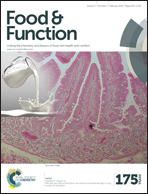Pepino polyphenolic extract improved oxidative, inflammatory and glycative stress in the sciatic nerves of diabetic mice
Abstract
The effect of pepino polyphenolic extract (PPE) on diabetic neuropathy was examined. Using HPLC/ESI-MS-MS analysis, PPE was demonstrated to contain coumaroyl and caffeoyl derivatives among polyphenols. PPE at 0.5 or 1% was supplied to diabetic mice for 12 weeks. The PPE intake at two doses significantly improved glycaemic control. These treatments reserved the glutathione (GSH) level, and decreased the thiobarbituric acid reactive substances (TBARS) level, reactive oxygen species (ROS), interleukin (IL)-6, tumour necrosis factor (TNF)-alpha, fructose, and glycation intermediates and precursors of advanced glycation end products (AGEs), such as methylglyoxal (MG) and N-(carboxymethyl)lysine (CML), in the sciatic nerves of diabetic mice. In a histological study of sciatic nerves, PPE had the effects in improving the nerves of diabetic mice, showing disorganization of the fascicle with numerous small myelinated fibers. The PPE intake at two doses retained the activity, and the protein and mRNA levels of glutathione peroxidase (GPX), and decreased protein expressions of aldose reductase (AR) and the receptor for the advanced glycation end product (RAGE) in sciatic nerves. These findings support that pepino polyphenolic extract could attenuate oxidative, inflammatory and glycative stress in diabetic peripheral nerves.


 Please wait while we load your content...
Please wait while we load your content...